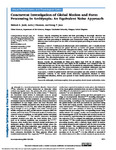Concurrent Investigation of Global Motion and Form Processing in Amblyopia: An Equivalent Noise Approach
| dc.contributor.author | Joshi, Mahesh Raj | |
| dc.contributor.author | Simmers, AJ | |
| dc.contributor.author | Jeon, ST | |
| dc.date.accessioned | 2020-09-15T08:41:41Z | |
| dc.date.available | 2020-09-15T08:41:41Z | |
| dc.date.issued | 2016-09-21 | |
| dc.identifier.issn | 1552-5783 | |
| dc.identifier.issn | 1552-5783 | |
| dc.identifier.uri | http://hdl.handle.net/10026.1/16296 | |
| dc.description.abstract |
PURPOSE: Directly comparing the motion and form processing in neurologic disorders has remained difficult due to the limitations in the experimental stimulus. In the current study, motion and form processing in amblyopia was characterized using random dot stimuli in different noise levels to parse out the effect of local and global processing on motion and form perception. METHODS: A total of 17 amblyopes (8 anisometropic and 9 strabismic), and 12 visually normal subjects monocularly estimated the global direction of motion and global orientation in random dot kinematograms (RDK) and Glass patterns (Glass), whose directions/orientations were drawn from normal distributions with a range of means and variances that served as external noise. Direction/orientation discrimination thresholds were measured without noise first then variance threshold was measured at the multiples of the direction/orientation threshold. The direction/orientation and variance thresholds were modelled to estimate internal noise and sampling efficiency parameters. RESULTS: Overall, the thresholds for Glass were higher than RDK for all subjects. The thresholds for both Glass and RDK were higher in the strabismic eyes compared with the fellow and normal eyes. On the other hand, the thresholds for anisometropic amblyopic eyes were similar to the normal eyes. The worse performance of strabismic amblyopes was best explained by relatively low sampling efficiency compared with other groups (P < 0.05). CONCLUSIONS: A deficit in global motion and form perception was only evident in strabismic amblyopia. Contrary to the dorsal stream deficiency hypothesis assumed in other developmental disorders, deficits were present in both motion (dorsal) and form (ventral) processing. | |
| dc.format.extent | 5015-5015 | |
| dc.format.medium | ||
| dc.language | en | |
| dc.language.iso | eng | |
| dc.publisher | Association for Research in Vision and Ophthalmology (ARVO) | |
| dc.subject | amblyopia | |
| dc.subject | motion perception | |
| dc.subject | form perception | |
| dc.subject | dorsal stream dysfunction | |
| dc.subject | noise | |
| dc.title | Concurrent Investigation of Global Motion and Form Processing in Amblyopia: An Equivalent Noise Approach | |
| dc.type | journal-article | |
| dc.type | Journal Article | |
| plymouth.author-url | https://www.webofscience.com/api/gateway?GWVersion=2&SrcApp=PARTNER_APP&SrcAuth=LinksAMR&KeyUT=WOS:000390156400061&DestLinkType=FullRecord&DestApp=ALL_WOS&UsrCustomerID=11bb513d99f797142bcfeffcc58ea008 | |
| plymouth.issue | 11 | |
| plymouth.volume | 57 | |
| plymouth.publication-status | Published | |
| plymouth.journal | Investigative Opthalmology & Visual Science | |
| dc.identifier.doi | 10.1167/iovs.15-18609 | |
| plymouth.organisational-group | /Plymouth | |
| plymouth.organisational-group | /Plymouth/Faculty of Health | |
| plymouth.organisational-group | /Plymouth/Faculty of Health/School of Health Professions | |
| plymouth.organisational-group | /Plymouth/REF 2021 Researchers by UoA | |
| plymouth.organisational-group | /Plymouth/REF 2021 Researchers by UoA/UoA03 Allied Health Professions, Dentistry, Nursing and Pharmacy | |
| plymouth.organisational-group | /Plymouth/Users by role | |
| plymouth.organisational-group | /Plymouth/Users by role/Academics | |
| dc.publisher.place | United States | |
| dc.identifier.eissn | 1552-5783 | |
| dc.rights.embargoperiod | Not known | |
| rioxxterms.versionofrecord | 10.1167/iovs.15-18609 | |
| rioxxterms.licenseref.uri | http://www.rioxx.net/licenses/all-rights-reserved | |
| rioxxterms.type | Journal Article/Review |


